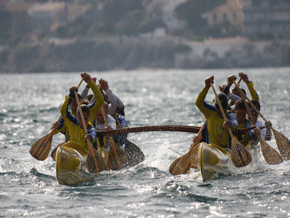-

"hibiscustour", three separate sites -
Islands and lagoons New Caledonia, Polynesia (part). -

Curiosity. Things, amazing, science, society.. -

Ideas perso. Household, Practical life, D.I.Y, Computering..
 
but reality |
  |
|
The maru, rural, so to speak, were distinguished in the islands by the wearing of their sarong under the breasts (man, of course).
|
According to tradition, Polynesians would like to be "corpulent" and for us to be fat. If there are any slender, we find numerous men and women they could be described as obese. |
|
|
For the Polynesians, Raïatea is said & quot; the sacred & quot; because of the manifestation in this place, the god
These islands have so far been spared by tourism, but the first large hotels with overwater bungalows have settled on both in 2003. Bill Gate (founder of Windows and Microsoft) acquired some bungalows in & nbsp; (Raïatea)..
One of the islands is not like the others: |
|
|
|

"Tahiti press", 29/10/2008.
- Matarii i Ni'a or the coming back of the abundance period, is related to the rise of the constellation of Pleiades in the Polynesian sky.
Dances and songs once honored this indication of the stars of a return to a period of abundance linked to the passage in the hot and humid season, favorable to the growth of the nourishing plants.
photo Tahiti Presse
|
|
From their ancestors, the Polynesians have inherited the passion of the sea through fishing, surfing and practice of the ancestral dugout, become the sport-king of all the archipelagoes : the "Le Hawaiki Nui Va'a". In Polynesia but also in France, in Brest and Toulon (France) ! some ancient dugouts were sewn! |
|
|
|
 Toulon (France) |
Va'a
Hawaiki Nui 2008
: Superbe photo "Tahiti Presse"
|
|
Hawaiki Nui 2008: the race Molokai Hoe (Hawaii) Text "Tahiti Presse.
Huahine - Raiatea (44,5 km) is the first stage of the va'a "Hawaiki Nui 2008" race. "This morning in Huahine was given the start of the Hawaiki Nui Va'a 2008. Va'a 85 crew (6 men per boat) took off from 7.30 am, towards Raiatea (Leeward Islands), 44.5 km distant. (Tahitipresse) - A thousand rowers will start Wednesday on the island of Huahine to reach remote Raiatea 44.5 km first stage of the Va'a race inter-island "Hawaiki Nui 2008. "The tension rises, the weather too, a heat wave that will make the race challenging for the 91 crews." "Meanwhile, Huahine is celebrating. Everywhere, simple huts or stalls along the main street which was held Tuesday, after the weighing of canoes, the opening ceremony of the festivities with the President of French Polynesia, and organizers of Hawaiki Nui. The personalities of the island including the Huahine mayor, were present. |
The winners, from the front, seem quite interested in this festive and ceremonial demonstration. "Hawaiki Nui is a breath of fresh air to the island's economy," said the mayor of Huahine to Tahitipresse. |


|
Tahiti In 1834, Catholic missionaries in France, already settled in the Gambiers, settle down; Papeete. Protestant pastors, including Georges Pritchard, have been settled for 12 years. These are putting pressure on the queen Aïmata Pomaré IV: The French are obliged to embark. To wash this affront, Captain A. Dupetit-Thouars (under Louis Philippe) is sent to ask for repair. the Queen (August 1838). A The struggle for influence ensues and the disorder sets in. The assembly of Tahitian chiefs then proclaimed the French protectorate to restore order. A Provisional Government is agreed with the English but Pritchard does not disarm and regains control over Pomaré; In 1844, A. Dupetit-Thouars had him deported, but England asked for it. its turn to repair! The affair gets worse and we talk about war .. but later, the pastor is indemnis & eacute; and France keeps the protectorate. In Tahiti however, it is the effervescence and the revival of 1844. 1846.It is necessary to fight again and the last rebels surrender on January 1, 1887. Queen Pomaré is loyal to the France and dies after 50 years of rehearsal (1887) by abandoning his rights o the France. (*) Due to the bacteriological shock (diseases) and acculturation (culture radically modified by the invaders) related to colonization, the population which was 70.000 inhabitants during its discovery by Europeans drops to only 7,000 including 400 French! the worst effects of colonization. |
New Caledonia In 1843, the government (Louis Philippe) plans to take possession of the New Caledonia. The French flag is planted ó À Stroll of 1843 à 1846. At that time, Minister Guizot had with England gives the order to withdraw it to prevent any further incidents. France is again interested by New Caledonia under the Second Republic and their co-ordination. the English get busy and plan the installation of a coal trap.
In 1853, the French imperial government sought to find land to establish a penal colony. Napoleon III
orders then the taking of possession and on September 24, 1853, Admiral Auguste Febvrier-Despointes hoisted a new hoist the French flag & agrave; Walk,
then on the 29th, on the Isle of Pines. No doubt one benefits from the alliance that England seeks with France in the Mediterranean.
Australia, it does not appreciate this change.
From 1864 to 1897, 22,000 convicts were received in the various prisons of the country. Some concessions have concessions. In the first few years, aboriginal people rebel from the coast. of Hienghène and the conflict arose because it was necessary to limit the land and those attributed to settlers. In 1878 a veritable insurrection under the leadership of Chief Ataï when the settlers bring their flocks. Seven months after and 200 deaths occurred for the Frenchs , a thousand of Kanak, Ataï is shot down by Segou, chief of Canala. Calm is restored in January 1879. |

|